This was the second half of my weekend spent in Philadelphia, Sunday, August 15, 2021, in which we see the famous "Rocky Steps," the Museum of the American Revolution, and an ill-advised two hours in nearby Trenton, New Jersey.
When I woke up Sunday morning, tt was kind of early and I had a few hours left before I had to check out of my hostel, most places weren't open yet, so I decided there was one landmark I wanted to go see and check off my list.
I rode the subway west, I'm not sure anymore to which station, stepped out and wandered in the general direction of a building I was trying to find. Eventually I found myself on the Schuylkill River Trail, a walking/running/cycling trail running north-south along the east bank of the Schuylkill ("school kill") River. There were many people out doing all three of those things on the scenic trail, making me wish I lived somewhere with such an amenity.
I made my way north on the trail for a little bit and then exited near a skate park called Paine Park. I passed the park and soon found what I was looking for...
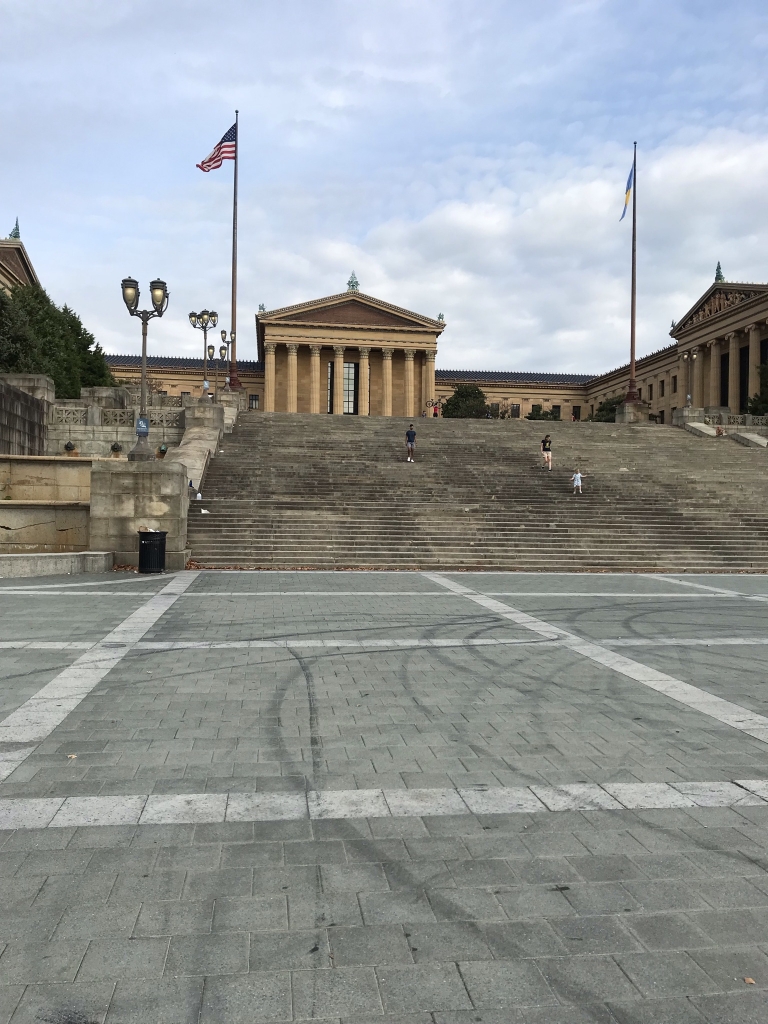
Now I can't get "Gonna Fly Now" out of my head! I wish I'd brought my running shoes so I could run up the steps here. The steps in front of the Philadelphia Museum of Art have been known as the "Rocky Steps" ever since Sylvester Stallone ran up them in the famous scene in the first Rocky movie.
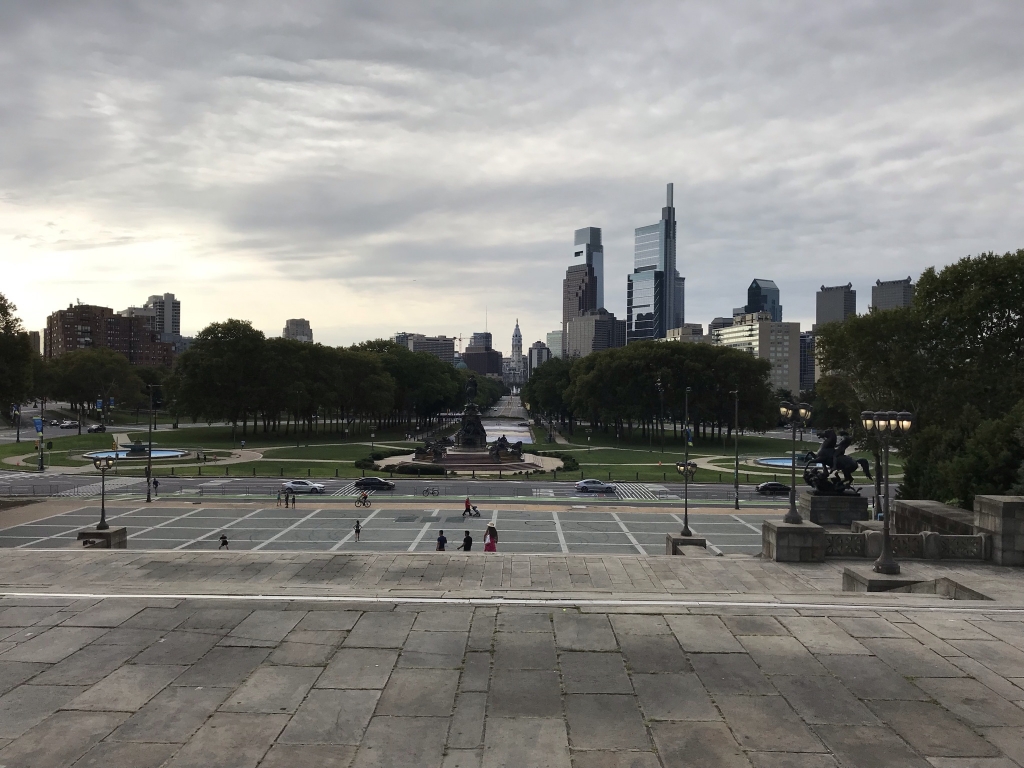
From on top the Rocky Steps you can get a great view of the city.
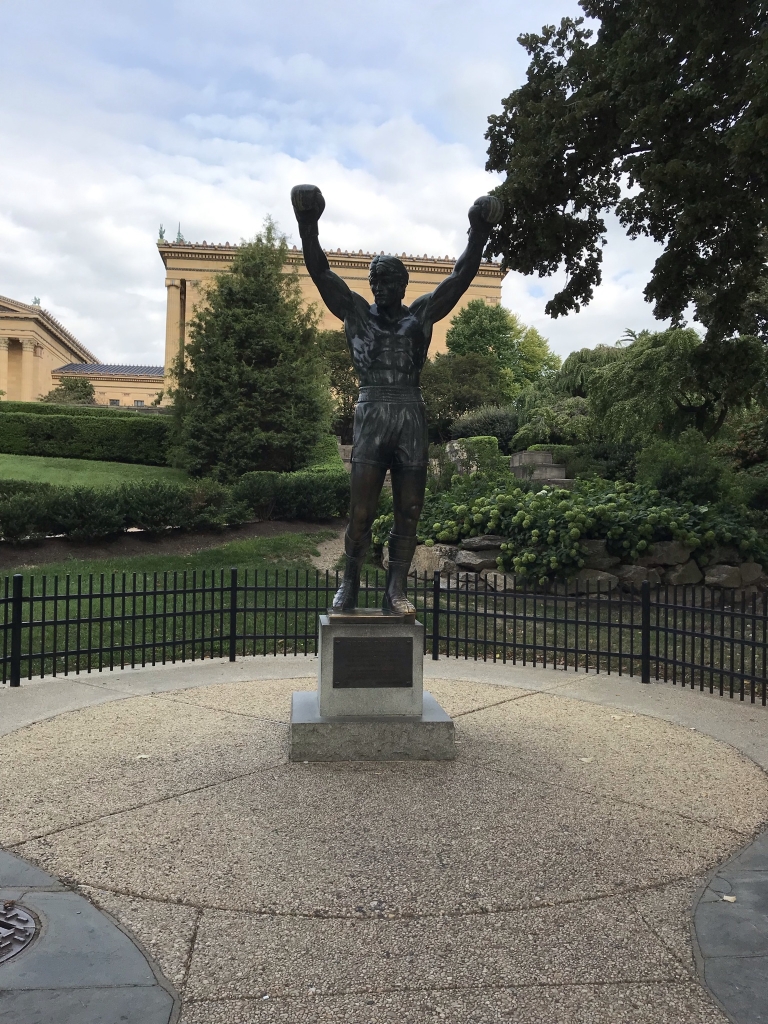
There's also a statue of Rocky, made for the 1982 film Rocky III, was placed at the top of the steps during the filming of that movie, but was later moved down here.
From there it was a long but scenic walk down Benjamin Franklin Parkway heading southeast toward downtown. This wide street is lined with every flag of every nation of the world and it stretches from the art museum towards City Hall, and about halfway between those two landmarks is a huge roundabout, somewhat misleadingly named Logan Square. This roundabout has a huge fountain in the center and is surrounded by scenic parks, one of which is called Sister Cities Park, and in Sister Cities Park is Sister Cities Café where I stopped a while for a coffee.
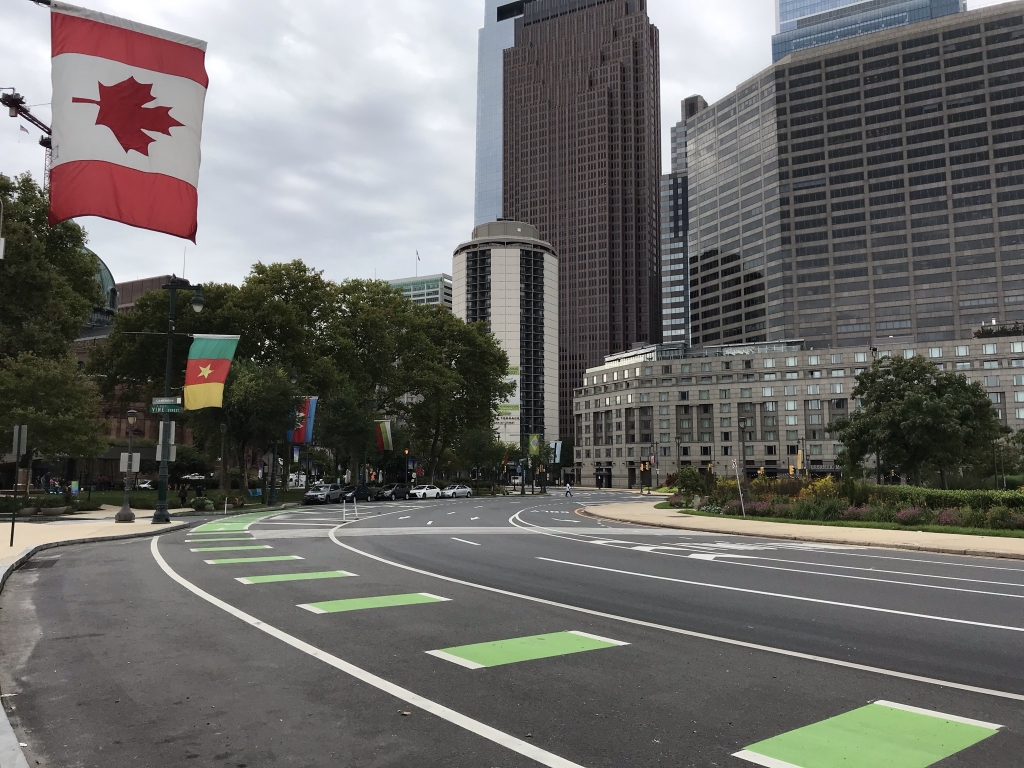
The roundabout in Logan Square at its intersection with Vine Street.
I finally made it back to the Apple Hostel, packed up my backpack, and checked out. Next stop: Museum of the American Revolution.
This was definitely a worthwhile experience. I only wish I had spent more time inside. I had something else planned for later which caused me to rush through the museum but turned out to be a waste of time. When you visit this museum, the first thing you should see is this introductory film in a small theater. This film only shows at specific times, so I spent the first several minutes before the next showing in a temporary exhibit...
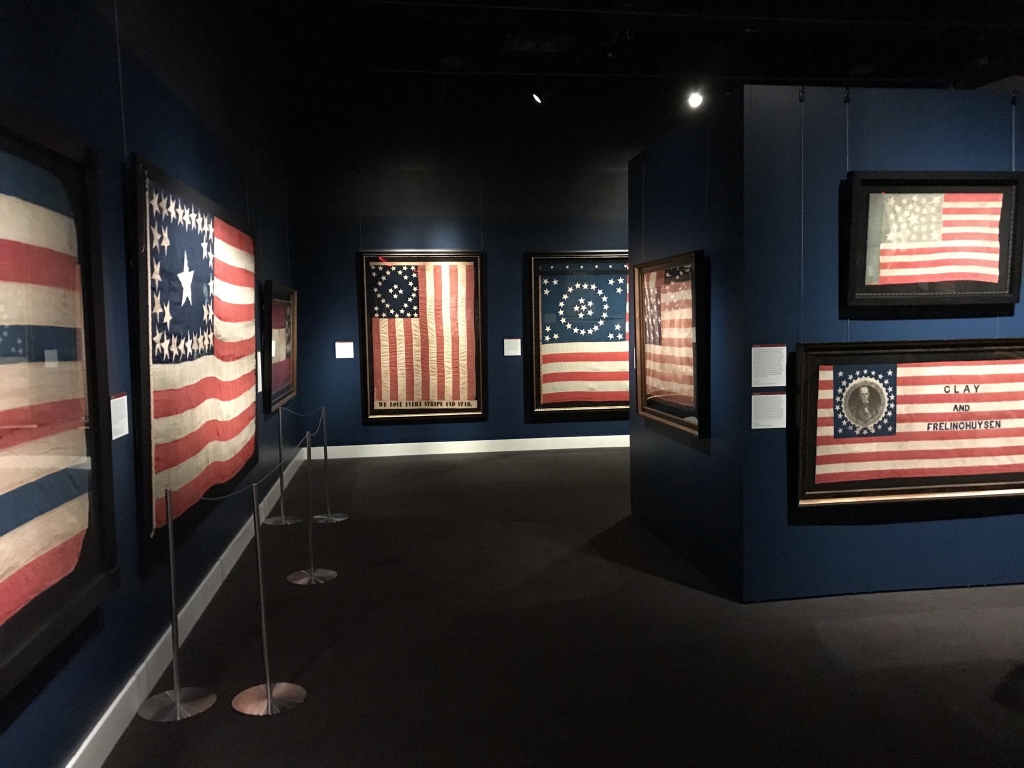
I think this exhibit was supposed to end sometime this September (2021). It shows off quite a few old copies of US founding documents and historic flags. Back in the 1800s, new states were being added almost every year, so there was never a fixed, official pattern for the stars on the American flag.
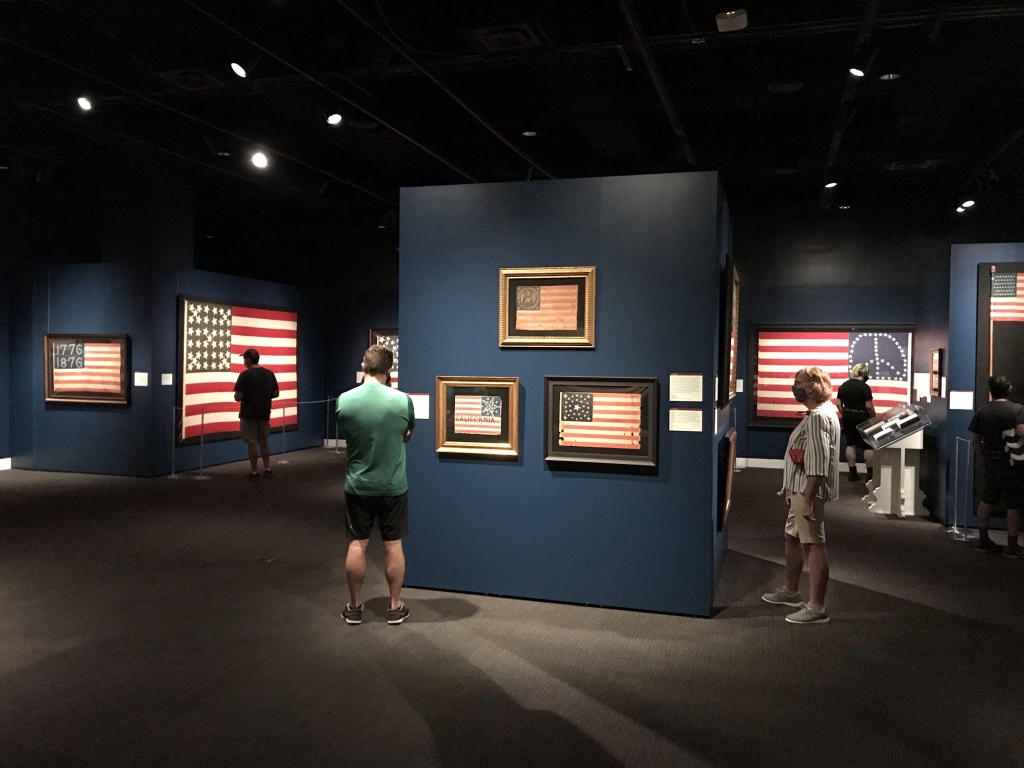
Here's some more flags, where you can see certain themed flags made for special occasions, like the 1776-1876 centennial flag, and the peace sign flag which came from the late-1960s counterculture.
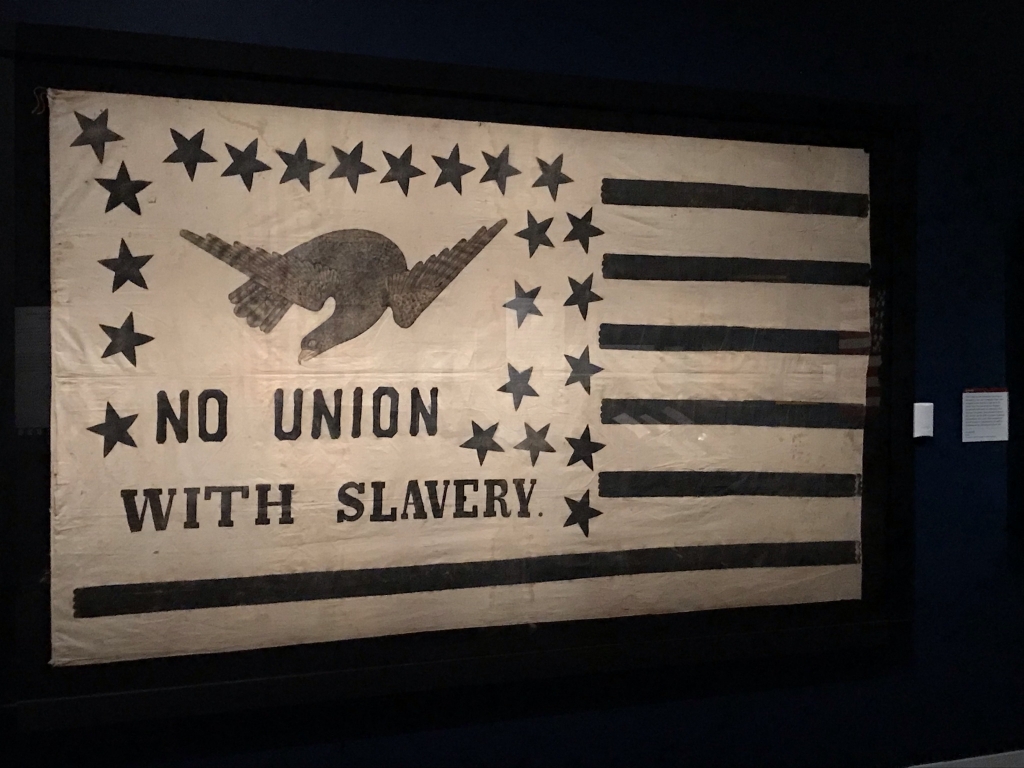
An abolitionist flag from before the Civil War.
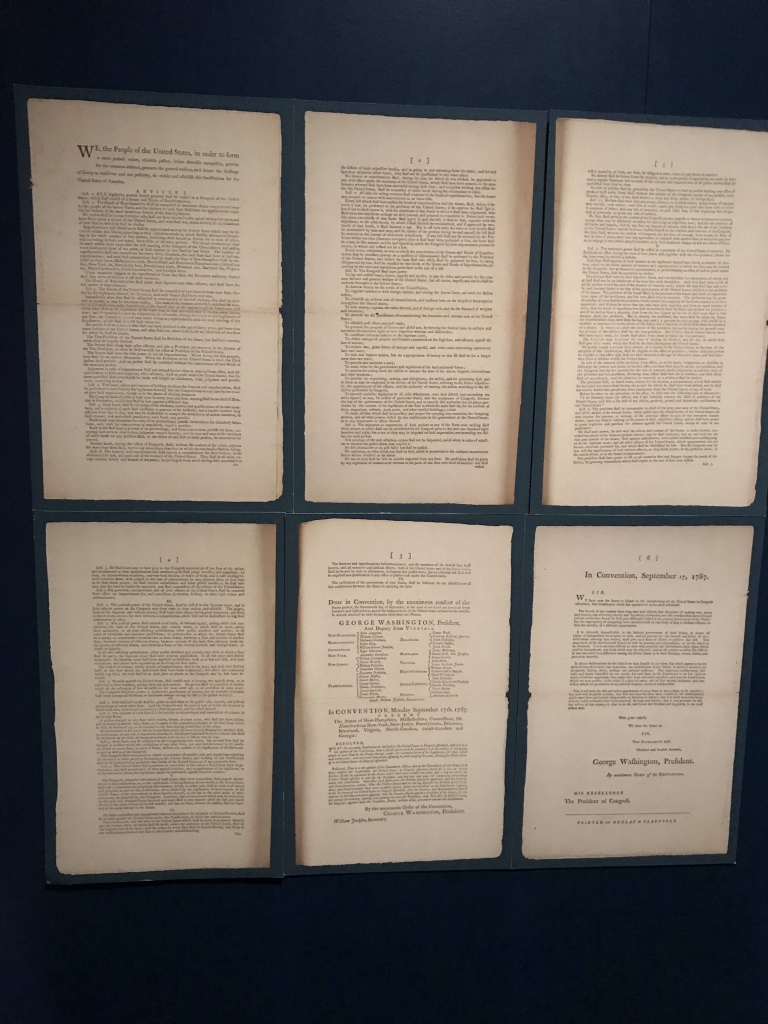
These are pages of one of the first printed copies of the US Constitution that rolled off the presses after it was first penned in 1787.
After looking over the flags and old documents, it was time for the introductory film to start. This was shown in a theater on the first floor a few steps away from the flag room. After that film, which I'm afraid I just don't remember much from, I could now explore the rest of this museum.
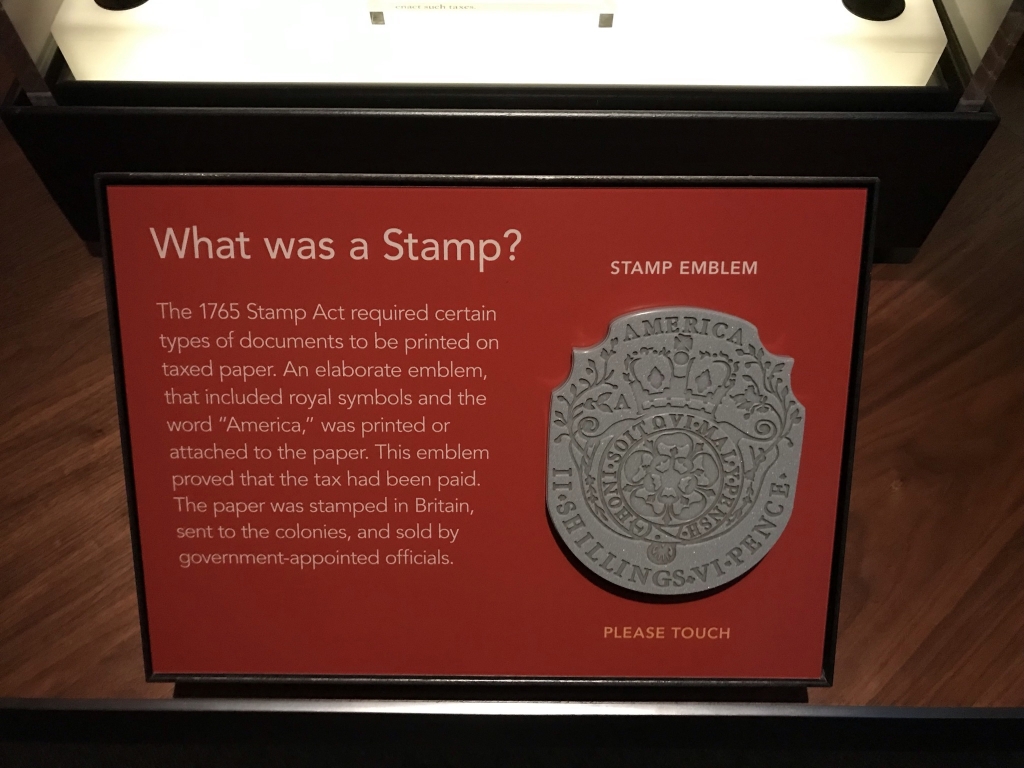
So we all remember the Stamp Act from our history lessons about the Revolution. Under this law, all newspapers, books, almanacs, legal documents, and decks of playing cards had to be printed on taxed paper which bore this stamp. As I've just read in Walter Isaacson's biography of Benjamin Franklin, this was the first time Parliament imposed an internal tax on the colonies, a tax on British goods, as opposed to an external tax like a tariff on foreign goods. The reason why this tax was so hated was because the colonies weren't represented in Parliament, and thus the people living in the colonies felt that Parliament had no right to tax them.
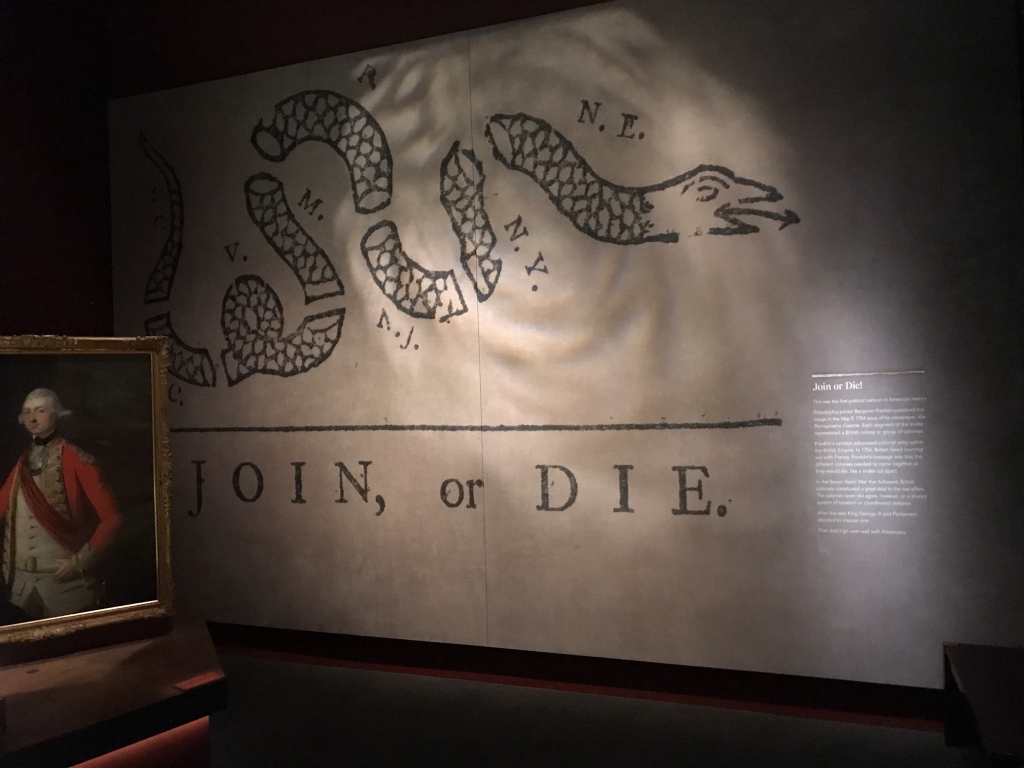
One of the most famous political cartoons was this one printed by Benjamin Franklin in his Pennsylvania Gazette in 1754. This wasn't anything to do with the Revolution directly, as it was still a couple decades away, but rather the so-called "French and Indian War" which was the American theater of Britain's Seven Years' War with France. This cartoon was advocating colonial unity, within the British Empire, in the face of French aggression.
Britain, with the help of its American colonial armies, won that war. That's how Britain took Québec and made it part of Canada. That war is also how George Washington first made a name for himself. Like all wars, it cost the British government quite a lot of money, and paying off the war debts was the main reason for the notorious Stamp Act.
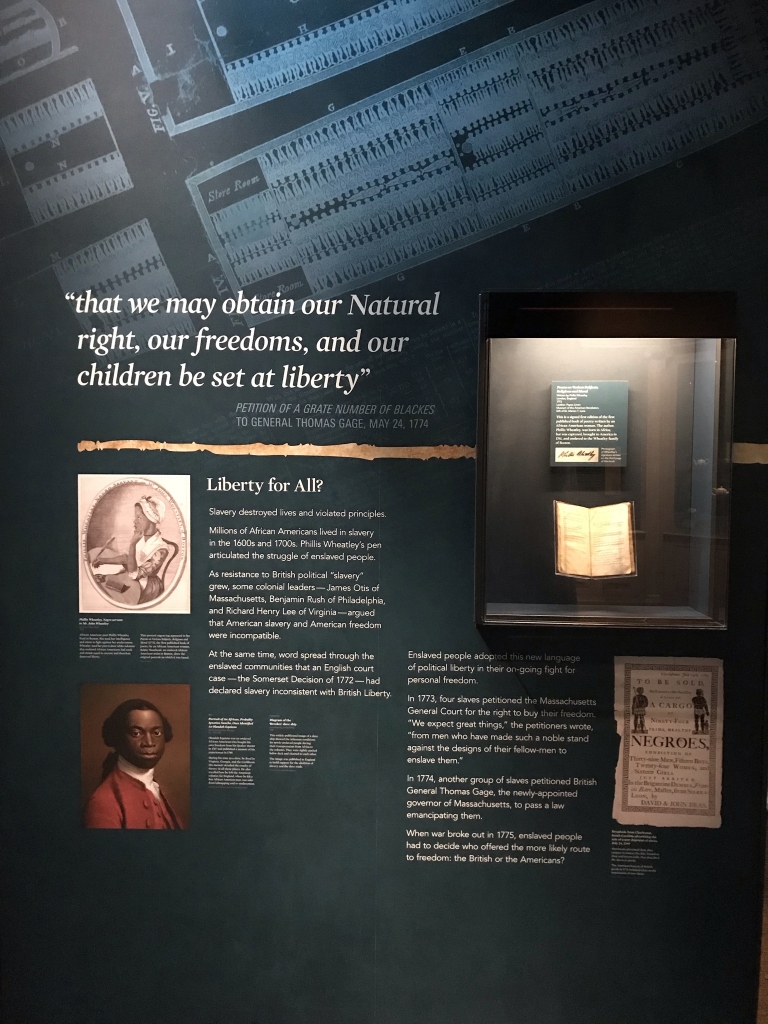
As much as this museum is a deep dive into, and greatly reveres, the revolutionaries' quest for liberty, it also takes an unflinching look at how many of those same people paradoxically owned other people. As the board says, "As resistance to British political 'slavery' grew, some colonial leaders--James Otis of Massachusetts, Benjamin Rush of Philadelphia, and Richard Henry Lee of Virginia--argued that American slavery and American freedom were incompatible." While we did learn that something between 3,000 and 5,000 African Americans fought on the side of the colonists, in the hopes that it would bring them freedom, we also learn that "for many of the enslaved, freedom wore a red coat." Because that was also true. The British could count around 7,000 to 10,000 black soldiers on their side, partially thanks to their recruitment efforts in the southern colonies.
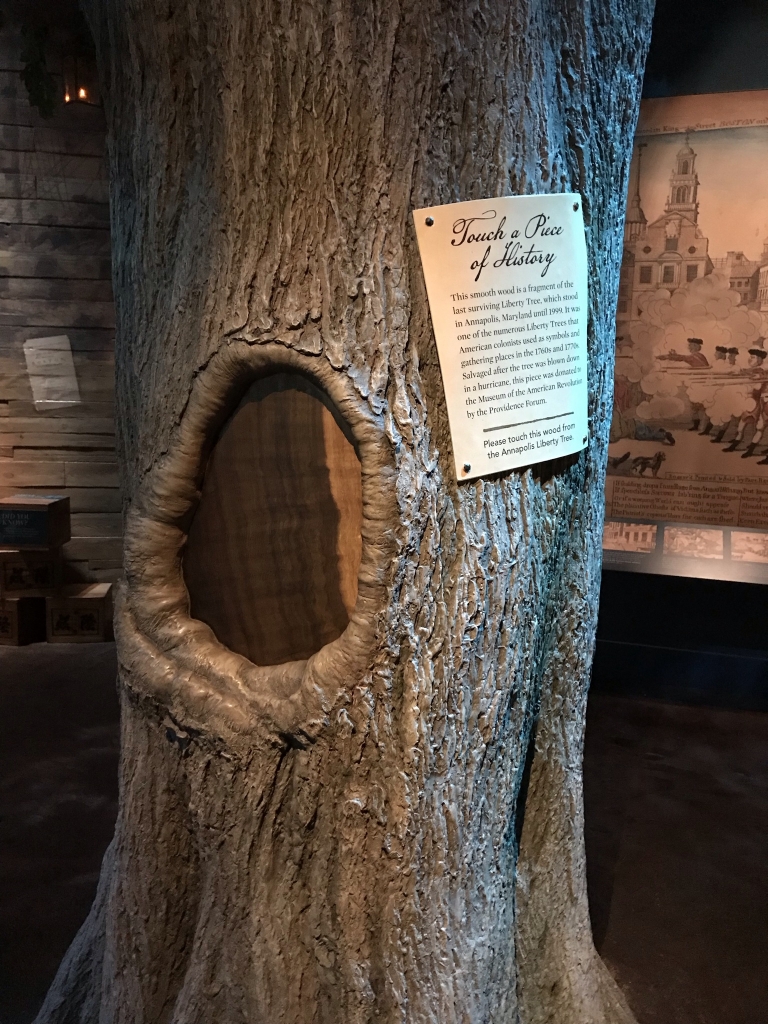
Revolutionary patriots used to meet under trees called "Liberty Trees." Here you can touch some real remaining wood from the last surviving Liberty Tree, which stood in Annapolis, Maryland until 1999.
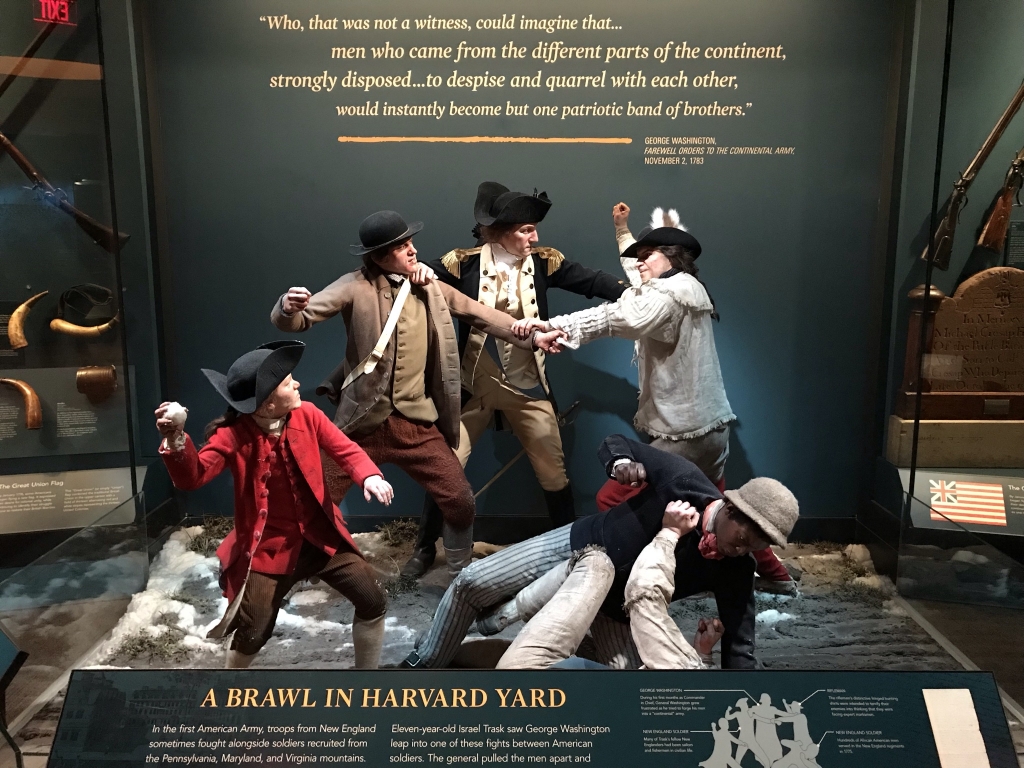
There were 13 colonies rebelling against the Crown, and they all had their different reasons for doing so, and their people came from different backgrounds. We all know that today someone from Georgia is going to have a pretty different attitude and worldview from someone from Massachusetts, and this was also the case in 1776. This display depicts a fight that broke out between militiamen from different colonies, that had to be broken up by George Washington himself. We know about it thanks to the writings of Israel Trask who was 11 years old when he witnessed it, and is depicted here as the kid on the bottom left with the snowball.
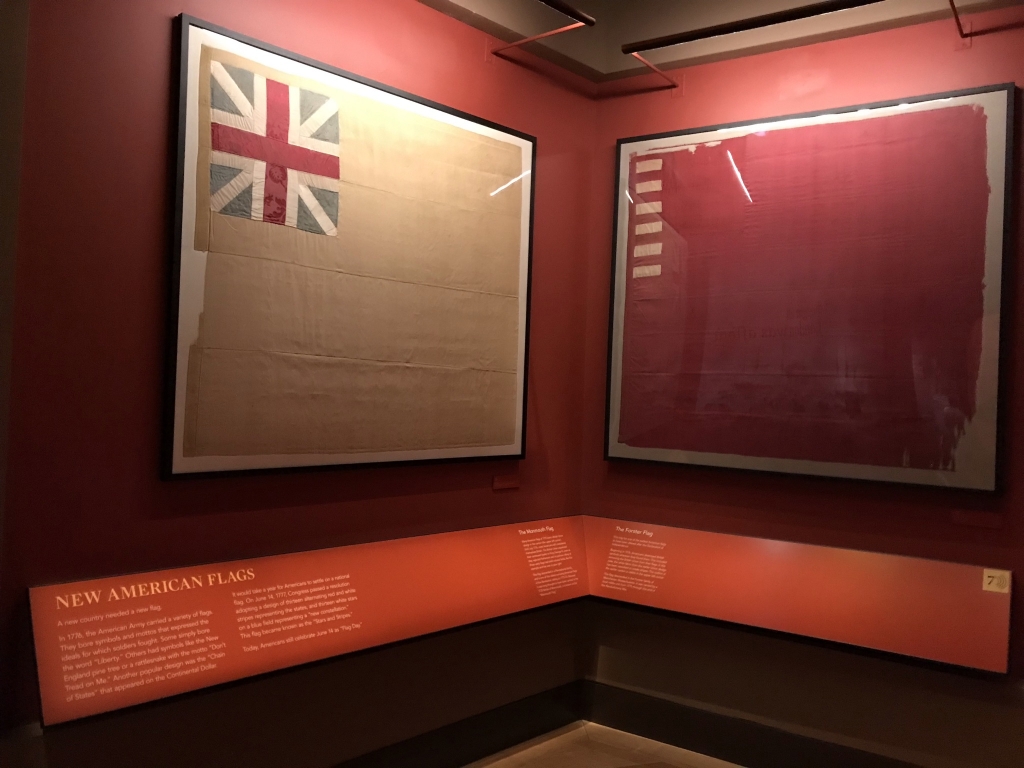
Here's a couple of early flags flown by the Revolutionaries. For much of the war they hadn't yet decided on a flag to use, in fact they couldn't even decide whether the 13 should stay together as a nation or go their separate ways after breaking away from Britain. The yellow flag on the left with the Union Jack (the British flag) in the corner is known as the Monmouth Flag. It was probably made in 1775 or 1776. It has a Union Jack because colonists still considered themselves British despite the conflict that was firing up. It's called the Monmouth Flag because it was flown at the 1778 Battle of Monmouth. The red flag on the right is called the Forster Flag. It was flown by the Manchester Militia in New Hampshire in 1775. Lt. Samuel Forster got ahold of the flag and passed it down in his family.
In one of the upstairs floors was another theater where another can't-miss presentation was being shown about George Washington's war tent. First you see a short film on the big screen about this tent. As an army general, Washington had a large tent which he used to plan battles with his officers and also to sleep in while in the field. The film explained that he had this tent set up right alongside all his men's tents, because he wanted to always be right there with them in the field and not far away and detached. As the film came to an end, the screens--there were actually several translucent screens, one behind another--slowly slid upward, one after the other, until they were all gone and a few lights began to illuminate an object standing in the dark space beyond...
It was George Washington's war tent, the real thing. The museum actually has it there. You can't take a picture of it, and they can't even let too much light touch it, to keep it preserved as best as possible. There was a long history behind how they got it, involving the tent being passed down in the family, being inherited by one of Washington's granddaughters who married Robert E. Lee, and then their daughter sold it to the Rev. W. Herbert Burk in Norristown, PA in 1909, who made it part of a museum which was a predecessor of this one.
After we got our look at the tent, an interpreter walked in. "Interpreters," in this context, are historical reenactors in period costumes who play the roles of specific historical people. This one was supposed to be Edward "Ned" Hector, one of the three-to-five thousand black soldiers who fought on the side of the colonists. He was born free, and so was never a slave, in Pennsylvania in 1743. During the Revolution, as a member of the 3rd Pennsylvania Artillery, he was a teamster--a driver of a horse-drawn wagon--supplying gunpowder for the cannons, and a bombardier who fired those cannons. He (the interpreter playing his role) told us all about this, and you can find out much more from his website.
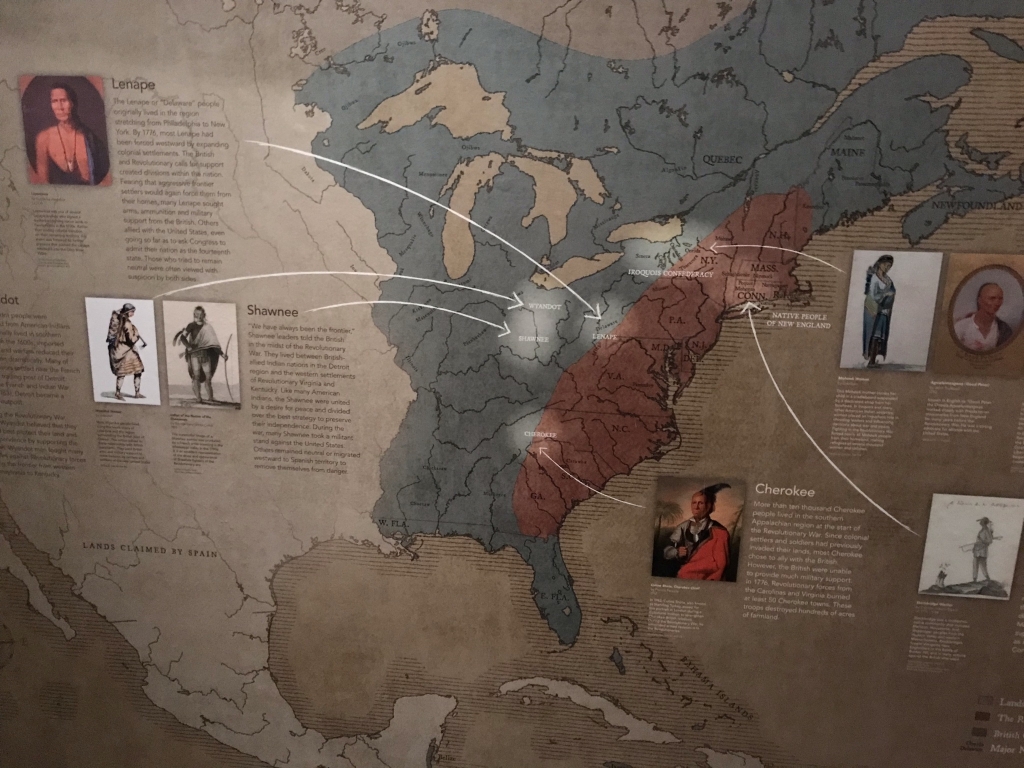
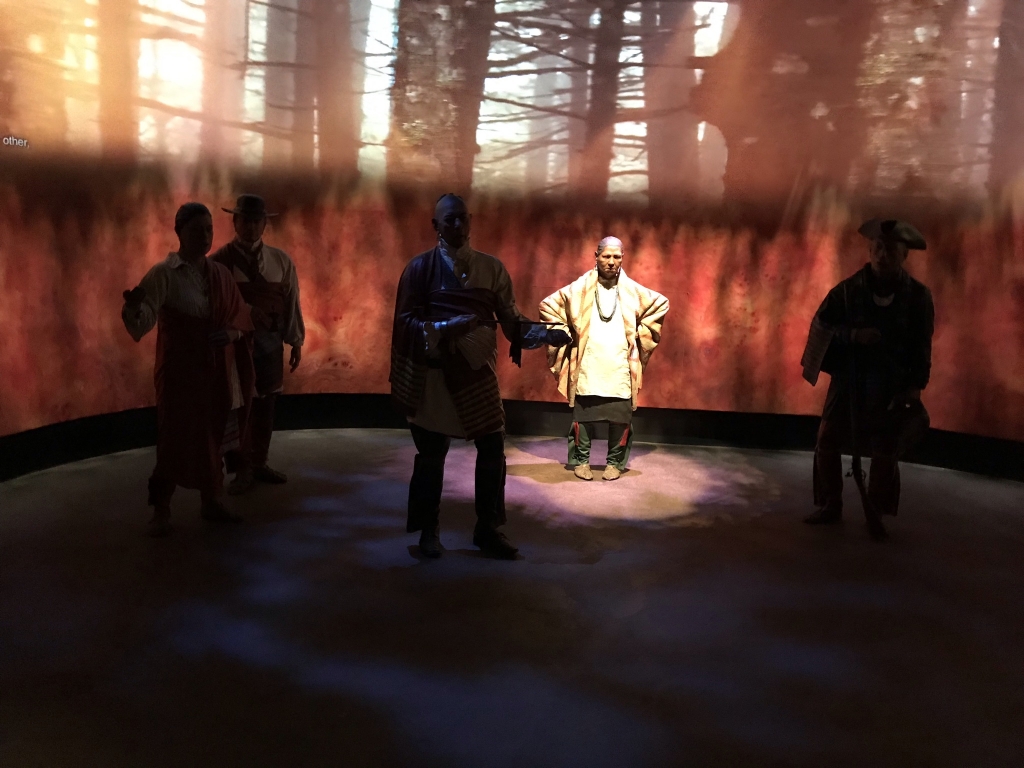
This area was about the various Native American nations and who they allied themselves with. Of the six Iroquois nations in the northeast, the Mohawk, Seneca, Onondaga, and Cayuga went with the British while the Tuscarora and Oneida allied with the Revolutionares. The situation doesn't seem to have been so clear-cut with the southeastern nations, like the Cherokee and the Creek, who were forcibly deported to what is now Oklahoma a generation later.
On the ground floor there was another interpreter. I found these interpreters to be more memorable and worthwhile than the walls of text. She was playing the role of a colonial-era schoolteacher. After enough people had gathered around, including "Ned Hector" for most of the time, first came the spelling lesson. She handed someone a small blackboard and told him to write "glass." So he wrote glass on the board. The teacher said "no, that's wrong." It's supposed to look more like glafs with the first s being the "long s" that resembled an f but with the crossbar only on the left side and not on both sides. What we recognize as an s was only used at the end of a word (or as a capital), with the long s used in any other position. "It looks like my cane, which I wish I had so I could whack you with it!"
Then we read aloud a few lines from the New England Primer, a widely used text that taught colonial children to read. "In Adam's fall, we sinned all." "Thy life to mend, this Book attend." Much of the verses from the Primer were clearly Biblically-inspired. As the teacher said while wrapping up her lesson, "If you're a child back then, there's a good chance you won't live to adulthood. So my job isn't just to teach you to read, but to save your soul."
There was a gift shop, where I looked over all the bookshelves and felt like I spent too much money on books I wanted eventually to read. I bought no less than four books here:
Never Caught: The Washingtons' Relentless Pursuit of their Runaway Slave, Ona Judge by Erica Armstrong Dunbar
Cultures and Identities in Colonial British America by Robert Olwell and Alan Tully
Autumn of the Black Snake: George Washington, Mad Anthony Wayne, and the Invasion that Opened the West by William Hogeland
Beer in America, The Early Years 1587-1840: Beer's Role in the Settling of America and the Birth of a Nation by Gregg Smith
That first one, Never Caught, looked interesting, as it was about someone I'd never heard of who obviously had quite a story. I've actually finished it now, having read it on train rides to and from Philly, NYC, and DC, and I recommend it as it's not only quite a gripping epic, but one that actually happened.
As for those other three, Cultures and Identities in Colonial British America stood out to me because I do want to learn more about the pre-Revolutionary colonial era, which I think is an overlooked period of US history. Autumn of the Black Snake was one I'd seen at various airport bookstores in previous years, I'd thought it looked interesting but always held off on buying it just yet. And also I'd kept forgetting the name of it except that it had "snake" in it. So when I got here I thought is that "snake" book in here? and when I found it I just had to finally buy the thing and not let it slip through my hands again. Finally Beer in America...it's about beer, I had to buy it!
They also had the Pulitzer-winning 1776 by David McCullough which I thought about buying, but instead thought I've got enough here, I'll buy that one somewhere else later. Which I did only two weeks later in DC.
There was also a café in the museum where I had lunch. It looks like a lot of their kitchen wasn't operational at that time so most of the options were from the grab-and-go shelf. I had, of all things, a ratatouille wrap. They also had beer available and there was one local brew I wanted to try, Yards. The one I had was Yards Jefferson Golden Ale, which I thought tasted better than anything I had the night before.
Now what is it that I was in a hurry to get through the museum for? I wanted to quickly visit Trenton, New Jersey. I'm on a mission to take a picture of every state capitol building in the country, and since Trenton was less than an hour away from Philadelphia on the SEPTA commuter train, this one seemed like an easy capture. Plus, there's a monument to the Battle of Trenton in the Revolutionary War, and I thought a visit there would perfectly cap off all the Revolution history I'd been taking in. So I set off for 30th Street Station, but first made an essential stop on the way...
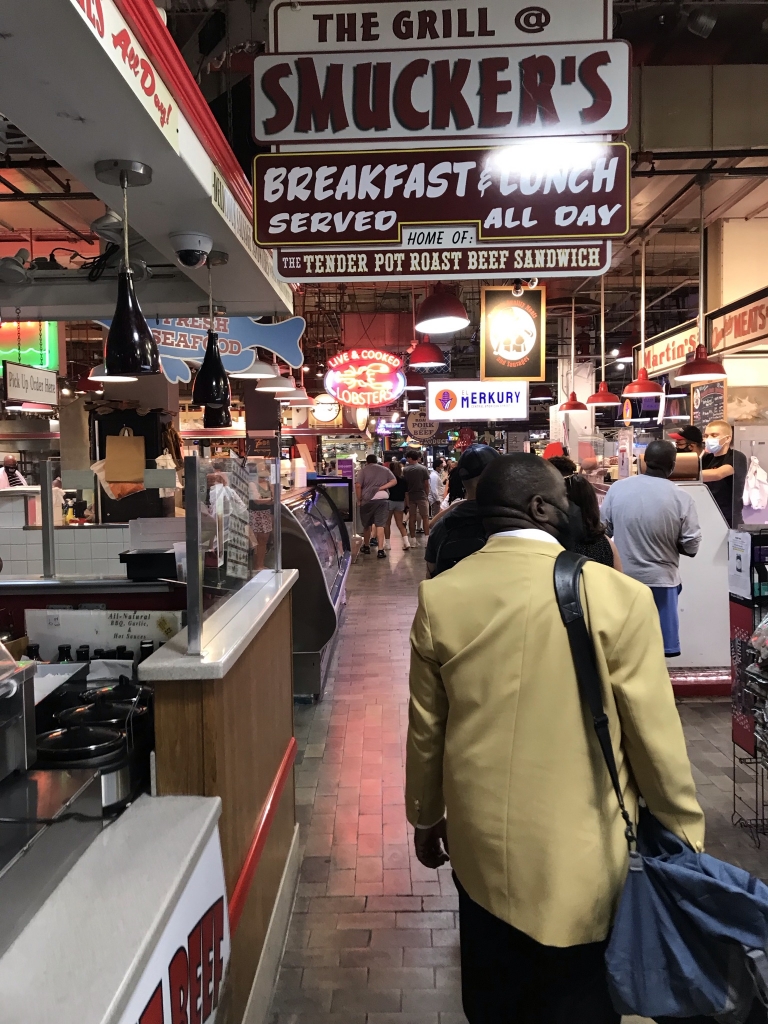
I needed to do some grocery shopping for the week, and really wanted to do this at Reading Terminal Market. This was a great place to stock up on fresh produce, which I did. I also stopped at a coffeeshop called Old City Coffee and got a bag of grounds, of a variety named Reading Blend.
And don't forget, the name Reading here is pronounced like "redding" with a short E. The market was originally a train station for the now-defunct Reading Railroad, which you may remember from the "Monopoly" game board and was named after a city in Pennsylvania.
Back at 30th Street Station, I bought a ticket for a SEPTA train to Trenton and boarded it a few minutes later. It took a little under an hour to get there. When a train crosses the Delaware River, and thus the PA-NJ state line, you see this bridge:
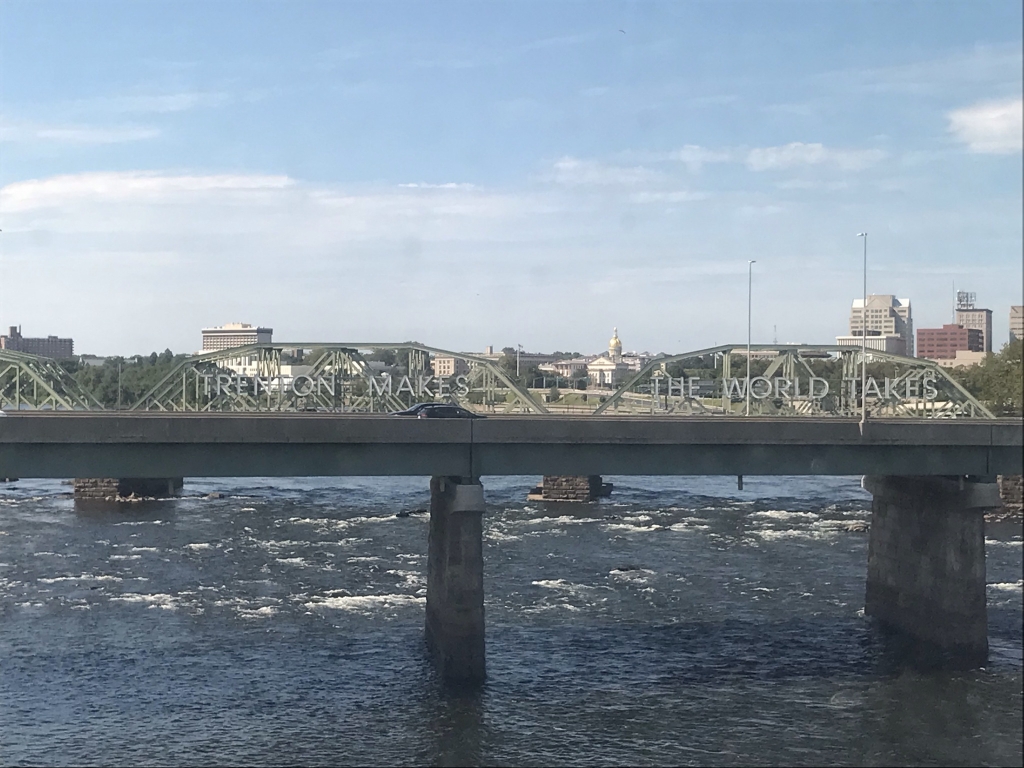
Notice that gleaming golden dome in the middle of this picture? That's actually the New Jersey state capitol, and sadly the best picture of that building I caught. The slogan on the bridge dates from a time when Trenton was a huge center of manufacturing.
My next mistake was choosing to walk to the capitol building, instead of taking a bus. This wasted too much time. I walked down State Street, and when I finally got to the Capitol, this is what I saw...
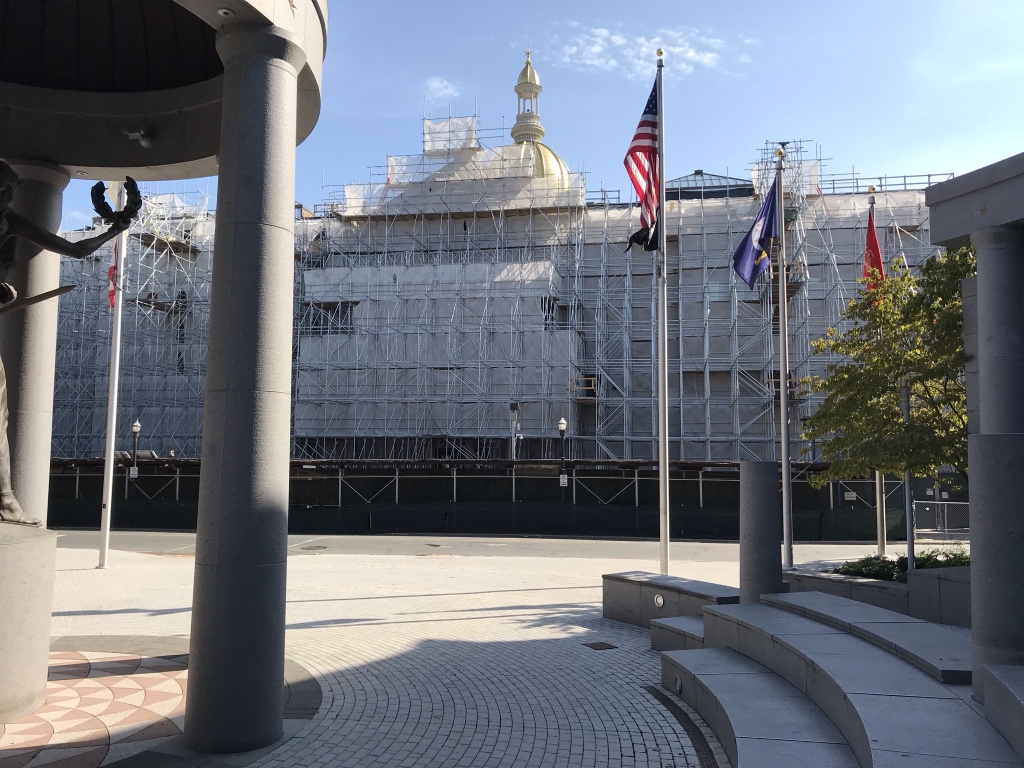
Of course, it's under renovation! Just like Big Ben when I visited London. I don't know when I'll be back here, so until then, this will have to count as my 12th state capitol picture.
OK, now what about that battle monument? So it's a tower that you're supposed to be able to go up stairs to the top and get a great view of this small city's downtown and of the river.
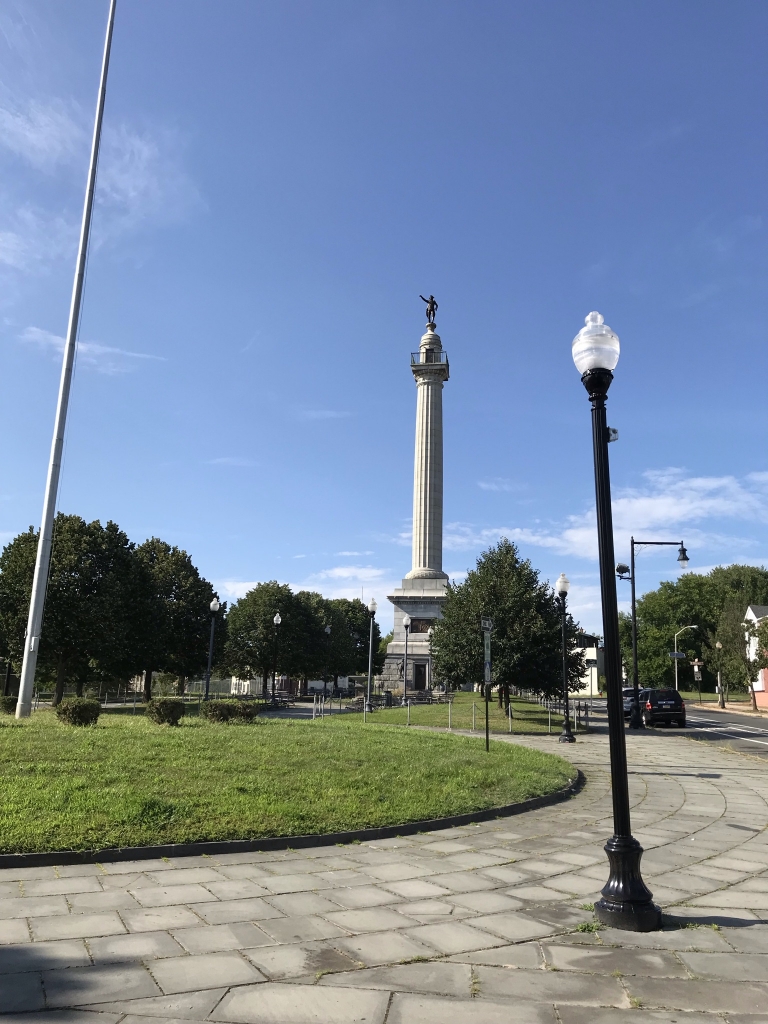
The door was locked, so this is all I could see.
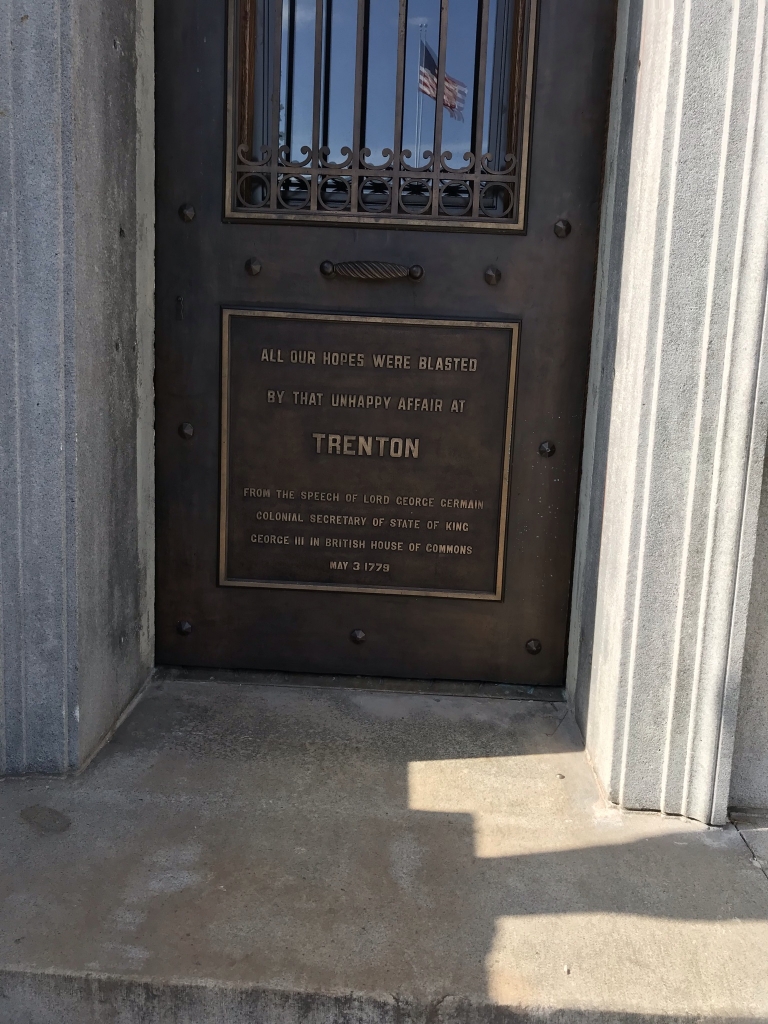
The locked door to the monument, commemorating Washington's victory here. Trenton was one of the more famous patriot victories in that war. That's the one that happened on the morning after Christmas 1776, in which General George Washington and his troops crossed the Delaware River--commemorated in a well-known painting--and defeated the German Hessians camped in the city.
On the way back to the train station I passed this old house.
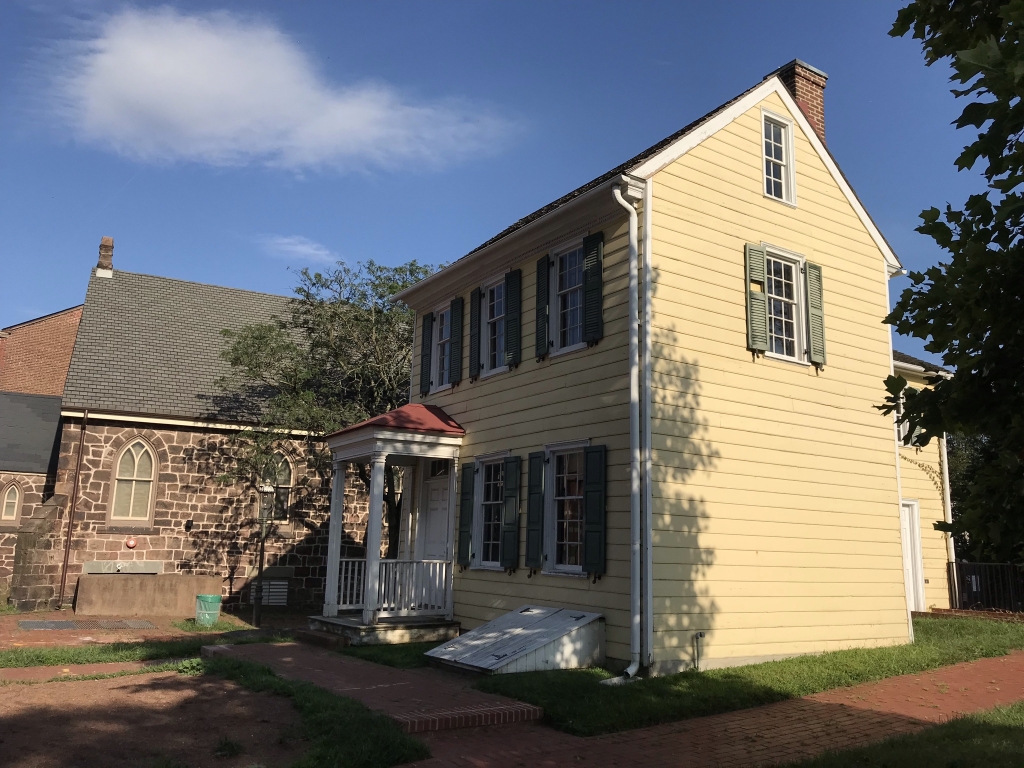
It seems this is the Alexander Douglass House. It has an interesting history. George Washington and his Council of War met in this house on January 2, 1777, shortly after vanquishing the Hessians in Trenton, to plan the subsequent assault on Princeton. Since then the house has been moved three times, and restored and remodeled so much that, bringing to mind the old "Ship of Theseus Problem," no one is sure how much of it actually existed during the Revolution.
Because I also missed the first train back to Philadelphia after my arrival, I had to spend more time waiting for the next one, about an hour after the one I missed. I got something from the McDonald's in the train station for dinner, because that was the only option there. I passed by a few restaurants and cafés in town, but they were all closed.
I might add here that nearly everywhere in Trenton was closed, either for the day or permanently, when I was there. The whole city center seemed eerily deserted. There were some people walking around but it was hardly bustling. Maybe that's just because it was Sunday evening?
I was back at Philadelphia's 30th Street Station for a half hour. They had a Jersey Mike's, one of my favorite sandwich restaurant chains, in the station. If only I could've waited a little longer, I thought, if only I could've just suffered through being hungry a couple more hours, I could've had Jersey Mike's instead of settling for McDonald's.
That night I would be going back to BWI on Amtrak's most famous train, the Acela Express. This is supposed to be the only high-speed train in America. It's definitely sleeker and more advanced than a standard Amtrak train, but after all the time I spent riding ICE trains in Germany I have a hard time calling Acela high-speed. The day before, my trip from BWI to Philadelphia lasted an hour and twenty minutes on the standard Northeast Regional. Going back the other way on the Acela Express lasted exactly the same amount of time. I think there are one or two stretches of track on the train's Boston-DC route on which the train can go faster, but I don't think they are anywhere between BWI and Philadelphia. But it was a pretty smooth ride in comfortable seats, and instead of just a rack above your seats to stow your luggage, there's compartments just like on an airplane. I spent most of the ride reading one of the books I bought, Never Caught.
And another thing about Acela, there's no "coach" class like on the other trains, only "business." So a ride on this train will always be a bit more expensive than on a different one. That's why I only rode it on Sunday night going back to BWI and not on Saturday morning going the other way, because it was the time in which I could get the cheapest fare, $46, which is a bargain compared to Acela's peak hours.
Well, that was my Philly weekend! Overall I really loved that city. There's still a lot I missed and would like to experience. I never got around to eating tomato pie or stromboli, two other dishes that were invented in Philadelphia. I would've liked to check out the bars in South Philly and have some more pints of Yards beer. I also wanted to spend more time on Passyunk Street, find a vinyl record store, drink some more local coffee. Reading Terminal Market had some nice looking restaurants which I never stopped at. I went too fast through the Museum of the American Revolution, and never got a chance to hit up Independence Hall or the Constitution Center...
But what I did see was unforgettable, and I'll have to return someday. I rode away feeling like this was my favorite American city, a title it would only hold for a week before I explored somewhere even better.

